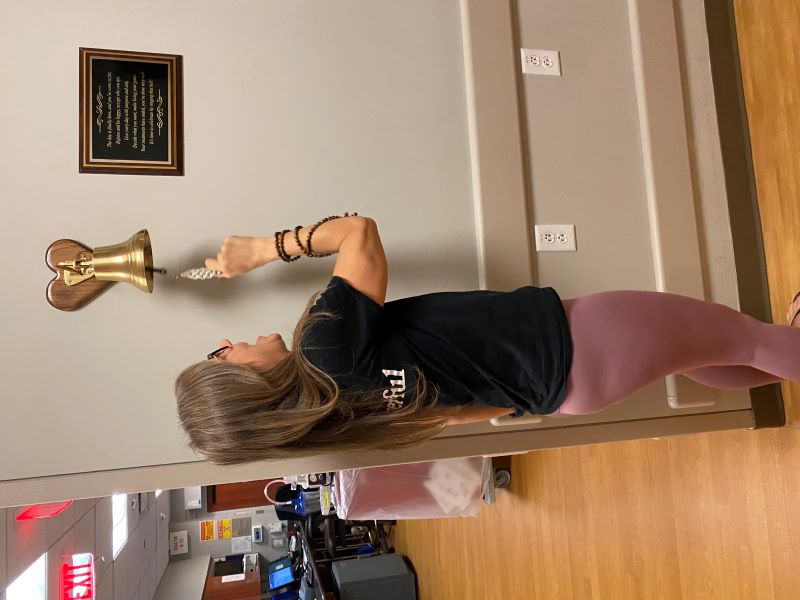 When Briana Eacott opened her eyes one morning in 1998, her view of the familiar objects in her bedroom was double and slanted. Eacott, 22 at the time, was diagnosed with a severe sinus infection and prescribed medication.
When Briana Eacott opened her eyes one morning in 1998, her view of the familiar objects in her bedroom was double and slanted. Eacott, 22 at the time, was diagnosed with a severe sinus infection and prescribed medication.
She eventually recovered her vision. But in 2004, when she had a second episode, an astute emergency physician questioned the first diagnosis and referred her to Austin ophthalmologist John Shore, MD, who suspected en plaque meningioma, a rare subtype of the slow-growing tumor that manifests as a diffuse growth adhering to the brain and adjacent bone. “It was growing like a sheet of sticky gum across the surface of my brain and down the sphenoid bone around my left eye’s orbit,” says Eacott, who now is 48 and teaches yoga in Austin.
When her vision deteriorated further in 2012, a team of neurosurgeons at UTHealth Houston Neurosciences removed the portion of the tumor they could access during a left-side craniotomy. Eacott continued to see multiple doctors, with her care guided by neurologist Sigmund Hsu, MD, assistant professor in the Vivian L. Smith Department of Neurosurgery at McGovern Medical School at UTHealth Houston and a key member of the UTHealth Houston Neurosciences neuro-oncology team. Hsu specializes in the treatment of patients with primary brain tumors, brain and spinal cord metastases, and chemotherapy neurotoxicity.
For the next few years, her visual problems presented in episodes that would last for a few months, then subside. By 2019, she had lost significant vision in her left eye, which also had stopped dilating. “Then in 2021, my vision started flickering in my right eye,” Eacott says. “At first it was occasional, but it became more frequent.”
The following year, after imaging showed the tumor was wrapped around her right optic nerve, neurosurgeons performed a right-side craniotomy and removed as much as they could. When her symptoms persisted, Hsu referred her to a vision rehabilitation therapist at TIRR Memorial Hermann.
“I live in Austin and all my specialists are in Houston, so I was driving back and forth for treatment and office visits,” she says. “Then I added a once-a-week visit to the therapist, who began to insist, after eye therapy, that something more was wrong. I was losing vision very rapidly in my right eye, and my field of vision was starting to go dark. It very much impacted my life.”
Hsu referred her to neuro-ophthalmologist Timothy McCulley, MD, professor and Richard S. Ruiz, MD, Distinguished University Chair of the Ruiz Department of Ophthalmology and Visual Science at McGovern Medical School. “During my first office visit, Dr. McCulley saw something new,” she says. “The tumor, he said, was inside the orbit surrounding my right optic nerve, causing the vision loss.
“He was very straightforward. He recommended radiation therapy, which carries a risk of blindness, but told me the flickering was a precursor to complete vision loss,” Eacott says. “I didn’t want radiation therapy and Dr. Hsu knew that, but he trusted Dr. McCulley enough to recommend moving forward with it. As much as I did not like hearing what Dr. McCulley told me, had he not said it, I likely would not have vision now.”
Within a few weeks, she started radiation therapy with Angel Blanco, MD, a radiation oncologist in the Vivian L. Smith Department of Neurosurgery. “The three doctors got together, came up with a plan, and started me on highly targeted, low-dose radiation therapy in my right eye. By the end of my treatment, the flickering had stopped,” says Eacott. “My last radiation treatment was in July 2023, and within less than a year, my vision had improved almost threefold, not only on the left side but also on the right. It has returned to a level of functioning that no one thought was possible. I can see and my vision is stable, so I can drive again, which makes everything easier.
“I’m grateful to my entire medical team, but Dr. McCulley has a very special place in my heart,” she adds. “Throughout my treatment, he checked up on me and was excited to see the progression in recovery of my vision. I’m very fortunate to have found him.”
“When Briana came to me, her left eye was atrophic and injured, and her right was swollen, indicating that the tumor was not involving the right optic nerve, approaching the back of the eye,” McCulley says. “We were able to diagnose the cause of her progressive vision loss and stabilize her. It’s tragic for anyone to lose sight, and we are grateful we could save her vision.”

 When Briana Eacott opened her eyes one morning in 1998, her view of the familiar objects in her bedroom was double and slanted. Eacott, 22 at the time, was diagnosed with a severe sinus infection and prescribed medication.
When Briana Eacott opened her eyes one morning in 1998, her view of the familiar objects in her bedroom was double and slanted. Eacott, 22 at the time, was diagnosed with a severe sinus infection and prescribed medication.